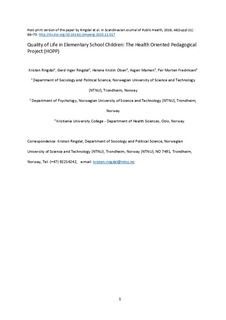Quality of life in primary school children: The Health Oriented Pedagogical Project (HOPP)
Journal article, Peer reviewed
Accepted version

Åpne
Permanent lenke
http://hdl.handle.net/11250/2596738Utgivelsesdato
2018Metadata
Vis full innførselSamlinger
- Institutt for psykologi [3105]
- Institutt for sosiologi og statsvitenskap [2811]
- Publikasjoner fra CRIStin - NTNU [38228]
Originalversjon
Scandinavian Journal of Public Health. 2018, 46 (21), 68-73. 10.1177/1403494818767821Sammendrag
Aims: The primary aim of the present study was to evaluate the association between parents’ level of education, measurements of physical attributes, and quality of life in a general sample of primary school children. Methods: The children’s and the parents’ versions of the Inventory of Life Quality in Children and Adolescents (ILC) were used to measure health-related quality of life (QOL) in 2140 school children (response rate 93%) and 1639 parents (response rate 71%) recruited from nine primary schools in Norway. A set of physical characteristics were also measured in the children: body mass index (BMI), waist circumference, average daily minutes of physical activity, aerobic fitness, and handgrip strength. Results: The regression analysis showed stronger relationships between the covariates and QOL for the parents’ assessments than for the children’s. Parents’ level of education was significantly related to children’s QOL, with the strongest association for parental QOL assessment. Among the physical variables, aerobic fitness (B = 0.01, p > .001 in both samples), and handgrip strength in the parents’ sample (B = 0.21, p < .05) were significantly related to the children’s QOL. Conclusions: The present study replicated the well-known finding that parents’ sociodemographic status is important for children’s QOL. Our new contribution is to show that the physiological variables aerobic fitness and muscular strength also contributed significantly to explain variance in QOL. This opens up interesting perspectives on how to improve QOL among children through more emphasis on physical activity and physical fitness in schools.